Submitted:
22 August 2023
Posted:
23 August 2023
You are already at the latest version
Abstract
Keywords:
1. Introduction (cross green, should be remove red)
2. Materials and Methods
3. Results and Discussion
4. Conclusions
Author Contributions
Institutional Review Board Statement
Informed Consent Statement
Acknowledgments
Conflicts of Interest
References
- Geim, A. K.; Novoselov, K.S. The rise of graphene. Nat Mater. 2007, 6, 183–191. [Google Scholar] [CrossRef] [PubMed]
- Zhang, H.; Virally, S.; Bao, Q.; Ping, L. K.; Massar, S.; Godbout, N.; Kockaert, P. Z-scan measurement of the nonlinear refractive index of graphene. Opt. Lett. 2012, 37, 1856–1858. [Google Scholar] [CrossRef] [PubMed]
- Bao, Q.; Zhang, H.; Wang, Y.; Ni, Z.; Yan, Y.; Shen, Z.; Loh, K. P.; Tang, D.Y. Atomic-Layer Graphene as a Saturable Absorber for Ultrafast Pulsed Lasers. Adv. Funct. Mater. 2009, 19, 3077–3083. [Google Scholar] [CrossRef]
- Mizrahi, V.; Delong, K. W.; Stegeman, G. I.; Saifi, M. A.; Andrejco, M.J. Two-photon absorption as a limitation to all-optical Switching. Opt. Lett. 1982, 14, 1140–1142. [Google Scholar] [CrossRef]
- Chantharasupawong, P.; Philip, R.; Narayanan, N. T.; Sudeep, P. M.; Mathkar, A.; Ajayan, P. M.; Thomas, J. Optical Power Limiting in Fluorinated Graphene Oxide: An Insight into the Nonlinear Optical Properties. J. Phys. Chem. C. 2012, 116, 25955–25961. [Google Scholar] [CrossRef]
- Zhu, Y.; Murali, S.; Cai, W.; Li, X.; Sul, J. W.; Potts, J. R.; Ruoff, R. S. Graphene and Graphene Oxide: Synthesis, Properties, and Applications. Adv Mater 2010, 22, 3906–3924. [Google Scholar] [CrossRef]
- Ren, J.; Zheng, X.; Tian, Z.; Li, D.; Wang, P.; Jia, B. Giant third-order nonlinearity from low-loss electrochemical graphene oxide film with a high-power stability. Appl. Phys. Lett 2016, 109, 221105. [Google Scholar] [CrossRef]
- Loh, K. P.; Bao, Q.; Eda, G.; Chhowalla, M. ; Graphene oxide as a chemically tunable platform for optical applications. Nat. Chem 2010, 2, 1015–1024. [Google Scholar] [CrossRef]
- Jiang, X. F.; Polavarapu, L.; Neo, S. T.; Venkatesan, T.; Xu, Q.H. Graphene Oxides as Tunable Broadband Nonlinear Optical Materials for Femtosecond Laser Pulses. J. Phys. Chem. Lett. 2012, 3, 785–790. [Google Scholar] [CrossRef]
- Xu, X.; Zheng, X.; He, F.; Wang, Z.; Subbaraman, H.; Wang, y.; Jia, B.; Chen, R.T. Observation of Third-order Nonlinearities in Graphene Oxide Film at Telecommunication Wavelengths. Sci. Rep. 2017, 7, 9646. [Google Scholar] [CrossRef]
- Burkins, P.; Kuis, R.; Basaldua, I.; Johnson, A. M.; Swaminathan, S. R.; Zhang, D.; Trivedi, S. Thermally managed Z-scan methods investigation of the size-dependent nonlinearity of graphene oxide in various solvents. JOSAB 2016, 33, 2395–2401. [Google Scholar] [CrossRef]
- Krishna, M. B. M.; Venkatramaiah, N.; Venkatesan, R.; Rao, D. N. Synthesis and structural, spectroscopic and nonlinear optical measurements of graphene oxide and its composites with metal and metal free porphyrins. J. Mater. Chem. 2010, 22, 3059. [Google Scholar] [CrossRef]
- Shan, Y.; Tang, J.; Wu, L.; Lu, S.; Dai, X.; Xiang, Y. Spatial self-phase modulation and all-optical switching of graphene oxide dispersions. J. Alloys Compd. 2019, 771, 900–904. [Google Scholar] [CrossRef]
- Bahae, M. S.; Said, A. A.; Wei, T. H.; Hagan, D. J.; Stryland, E.W. Sensitive measurement of optical nonlinearities using a single beam. IEEE J. Quantum Electron. 1990, 26, 760–769. [Google Scholar] [CrossRef]
- Durbin, S. D.; Arakelian, S. M.; Shen, Y.R. Laser-induced diffraction rings from a nematic-liquid-crystal film. Opt. Lett. 1981, 6, 411–413. [Google Scholar] [CrossRef]
- Callen, W. R.; Huth, B. G.; Pantell, R.H. Optical Patterns of Thermally Self-Defocused Light. Appl. Phys. Lett. 1967, 11, 103–105. [Google Scholar] [CrossRef]
- Kean, P. N.; Smith, K.; Sibbett, W. Spectral and temporal investigation of self-phase modulation and stimulated Raman scattering in a single-mode optical fibre. IEE Proceeding 1987, 134, 163–167. [Google Scholar] [CrossRef]
- Neupane, T.; Wang, H.; Yu, W. W.; Tabibi, B.; Seo, F. J. Second order hyperpolarizability and all-optical-switching of intensity-modulated spatial self-phase modulation in CsPbBr1.5I1.5 perovskite quantum dot. Opt. Laser Technol. 2021, 140, 107090. [Google Scholar] [CrossRef]
- Neupane, T.; Tabibi, B.; Kim, W.-J.; Seo, F.J. Spatial Self-Phase Modulation in Graphene-Oxide Monolayer. Crystals 2023, 13, 271. [Google Scholar] [CrossRef]
- Neupane, T.; Tabibi, B. ; Kim, Seo, F.J. Spatial Self-Phase Modulation in Ws2 and MoS2 atomic layer. Opt. Mater. Express, 2020, 8, 831–842.
- Woodward, R. I.; Kelleher, E. J. R.; Howe, R. C. T.; Hu, G.; Torrisi, F.; Hasan, T.; Popov, S.V.; Taylor, J.R. Tunable Q-switched fiber laser based on saturable edge-state absorption in few-layer molybdenum disulfide (MoS2). Opt. Express 2014, 22, 31113–31122. [Google Scholar] [CrossRef]
- Wang, J.; Gu, B.; Wang, H. T.; Ni, X.W. Z-scan analytical theory for material with saturable absorption and two photon absorption. Opt. Commun. 2010, 283, 3525–3528. [Google Scholar] [CrossRef]
- Bahae, M. S.; Said, A. A.; Stryland, E. W. High-sensitivity, single-beam n2 measurements, Opt. Lett. 1989, 14, 955–957. [Google Scholar]
- Kang, L.; Sato, R. Zhang, B.; Takeda, Y.; Tang, J. Experimental dispersion of the third-order optical susceptibility of graphene oxide. Opt. Mater. Express 2020, 10, 3041–3050. [Google Scholar] [CrossRef]
- Chantharasupawong, P.; Philip, R.; Endo, T. ; Thomas, J Enhanced optical limiting in nanosized mixed zinc ferrites. Appl. Phys. Lett. 2012, 100, 221108. [Google Scholar] [CrossRef]
- Philip, R.; Chantharasupawong, P.; Qian, H.; Jin, R.; Thomas, J. Evolution of nonlinear optical properties: From gold atomic clusters to plasmonic nanocrystals. Nano Lett. 2012, 12, 4661–4667. [Google Scholar] [CrossRef] [PubMed]
- Seo, J. T.; Ma, S. M.; Yang, Q.; Creekmore, L.; Battle, R.; Brown, H.; Jackson, A.; Skyles, T.; Tabibi, B.; Yu, W.; Jung, S. S.; Namkung, M. Large resonant third-order optical nonlinearity of CdSe nanocrystal quantum dots. J. Phys. Conf. Ser. 2006, 38, 91–95. [Google Scholar] [CrossRef]
- Liaros, N.; Iliopoulos, K.; Stylianakis, M. M.; Koudoumas, E.; Couris, S. Optical limiting action of few layered graphene oxide dispersed in different solvents. Opt. Mater. 2013, 36, 112–117. [Google Scholar] [CrossRef]
- Feng, M.; Zhan, H.; Chen, Y. Nonlinear optical and optical limiting properties of graphene families. Appl. Phys. Lett. 2010, 96, 033107. [Google Scholar] [CrossRef]
- Fang, C.; Dai, B.; Hong, R.; Tao, C.; Wang, Q.; Wang, X.; Zhang, D.; Zhuang, S. Tunable optical limiting optofluidic device filled with graphene oxide dispersion in ethanol. Sci. Rep. 2015, 5, 15362. [Google Scholar] [CrossRef]
- Ebrahimi, M.; Zakery, A.; Karimipour, M.; Molaei, M. Nonlinear optical properties and optical limiting measurements of graphene oxide - Ag@TiO2 compounds. Opt. Mater. 2016, 57, 146–152. [Google Scholar] [CrossRef]
- Coleman, J. N.; Khan, U.; Young, K.; Gaucher, A.; De, S.; Smith, R. J.; Shvets, I. V.; Arora, S. K.; Stanton, G.; Kim, H.; Lee, K.; Kim, G. T.; Duesberg, G.S.; Hallam, T.; Boland, J. J.; Wang, J. J.; Donegan, J. F.; Grunlan, J. C.; Moriarty, G.; Shmeliov, A.; Nicholls, R. J.; Perkins, J. M.; Grieveson, E. M.; Theuwissen, K.; Mccomb, D. W.; Nellist, P. D.; Nicolosi, V. Two-Dimensional Nanosheets Produced by Liquid Exfoliation of Layered Materials. Science 2011, 331, 568–571. [Google Scholar] [CrossRef] [PubMed]
- Neupane, T.; Yu, S.; Rice, Q.; Tabibi, B.; Seo, F.J. Third-order optical nonlinearity of tungsten disulfide atomic layer with resonant excitation. Opt. Mat. 2019, 96, 109271. [Google Scholar] [CrossRef]
- Shang, J.; Li, J.; Ai, W.; Yu, T.; Gurzadyan, G.G. The Origin of Fluorescence from Graphene Oxide. Sci Rep. 2012, 2, 792. [Google Scholar] [CrossRef] [PubMed]
- Kimiagar, S.; Abrinaei, F. Effect of temperature on the structural, linear, and nonlinear optical properties of MgO-doped graphene oxide nanocomposites. Nanophotonics 2017, 7, 243. [Google Scholar] [CrossRef]
- Neupane, T.; Rice, Q.; Jung, S.; Tabibi, B. ; Kim, Seo, F.J. Cubic Nonlinearity of Molybdenum Disulfide Nanoflakes. J. nanoscience and nanotechnology 2020, 20, 4373–4375. [Google Scholar] [CrossRef] [PubMed]
- Kwak, C. H.; Lee, Y. L.; Kim, S. G. ; Analysis of asymmetric Z-scan measurement for large optical nonlinearities in an amorphous As2S3 thin film. J. Opt. Soc. Am B 1999, 16, 600–604. [Google Scholar] [CrossRef]
- Martin, K.; Spinks, D. Measurement of the speed of sound in ethanol/water mixture. Ultrasound Med. Biol. 2001, 27, 289–291. [Google Scholar] [CrossRef]
- Seo, J. T.; Yang, Q.; Creekmore, S.; Temple, D.; Yoo, K. P.; Kim, S. Y.; Jung, S. S.; Mott, A. Large pure refractive nonlinearity of nanostructure silica aerogel at near infrared wavelength. Appl Phys Lett. 2003, 82, 4444–4446. [Google Scholar] [CrossRef]

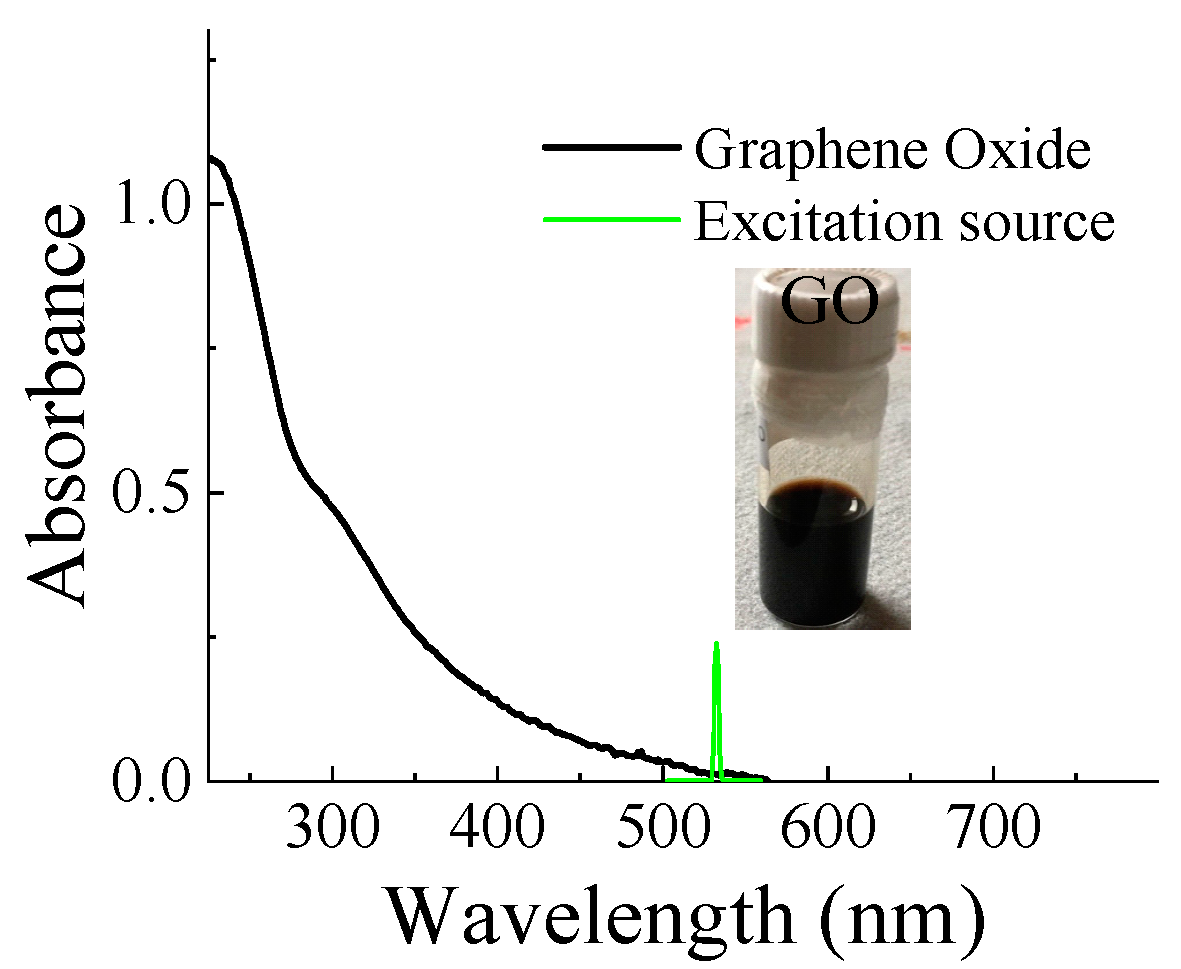
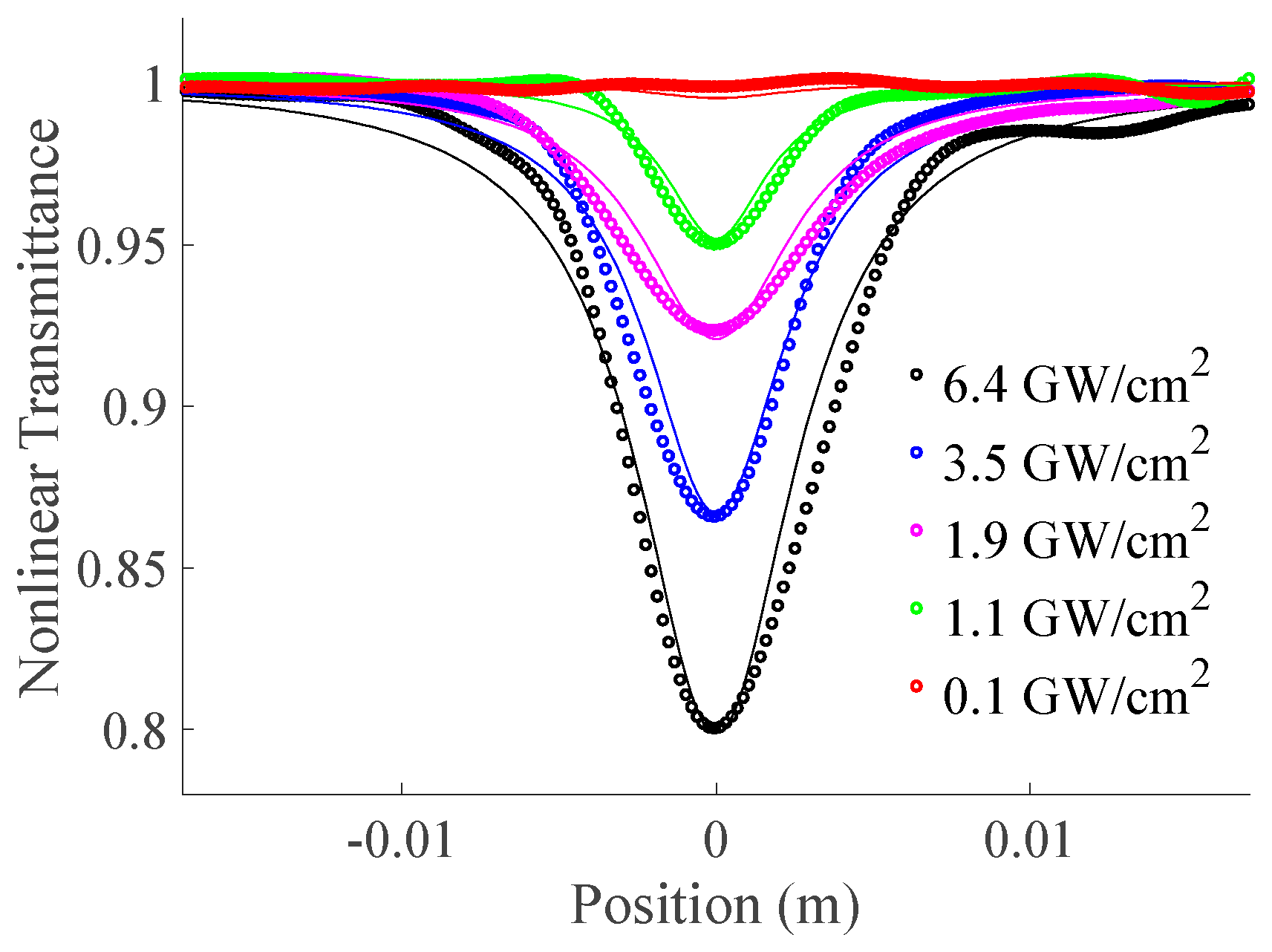
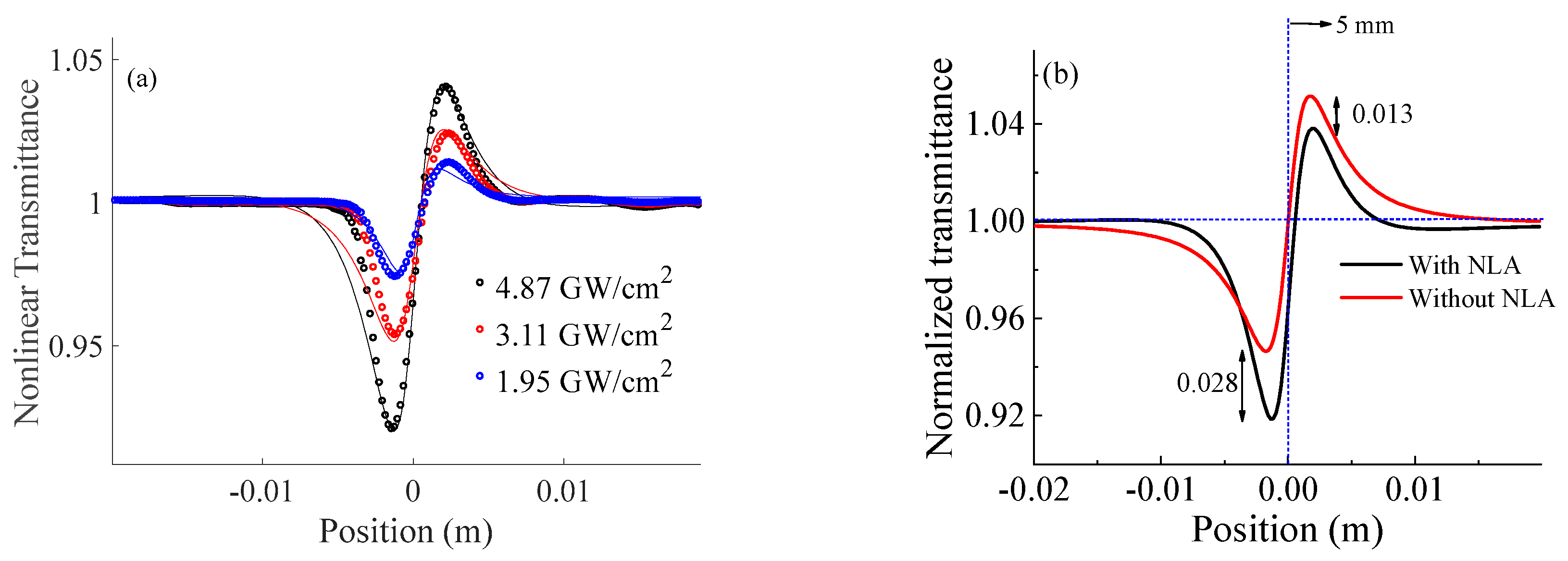
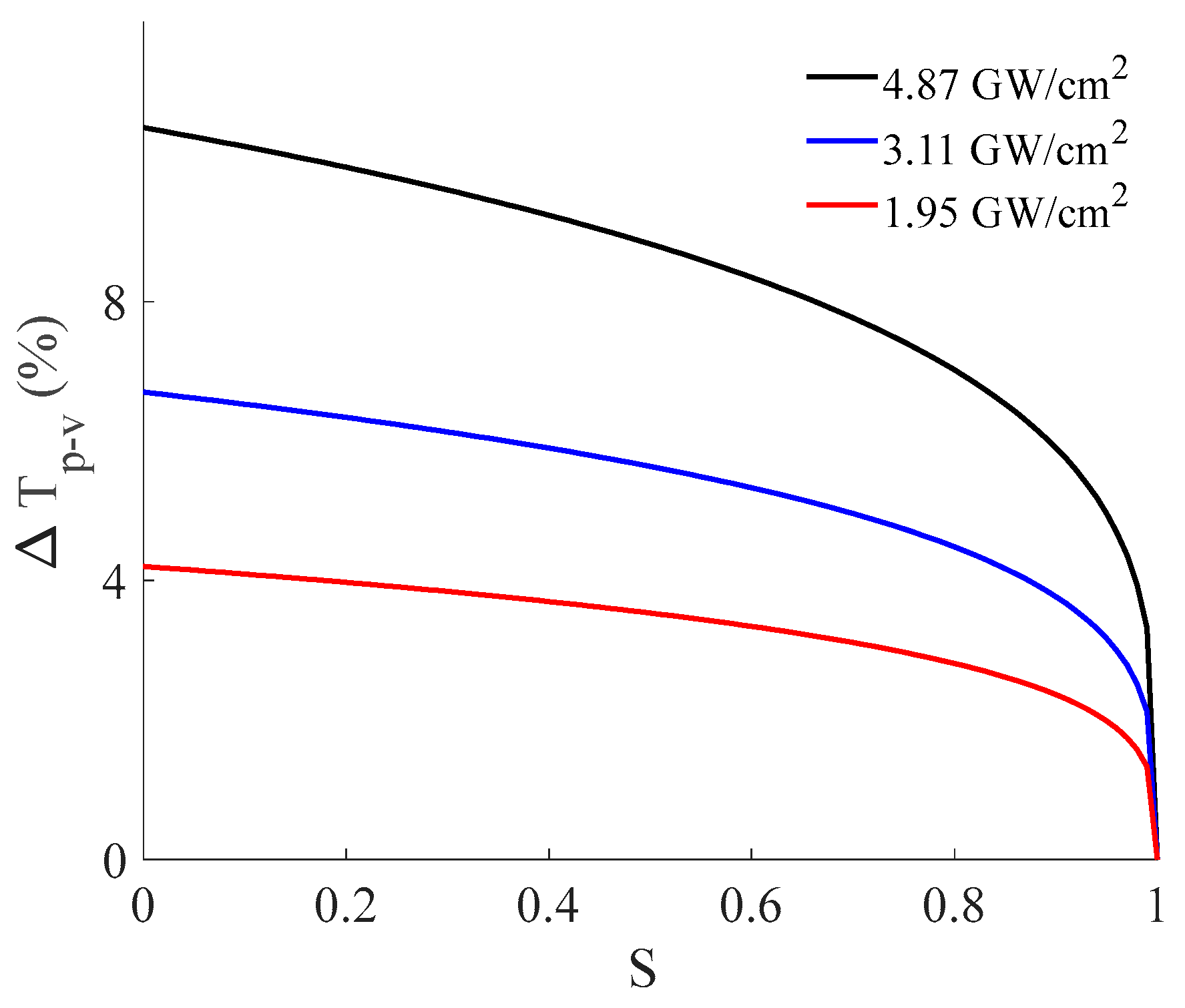
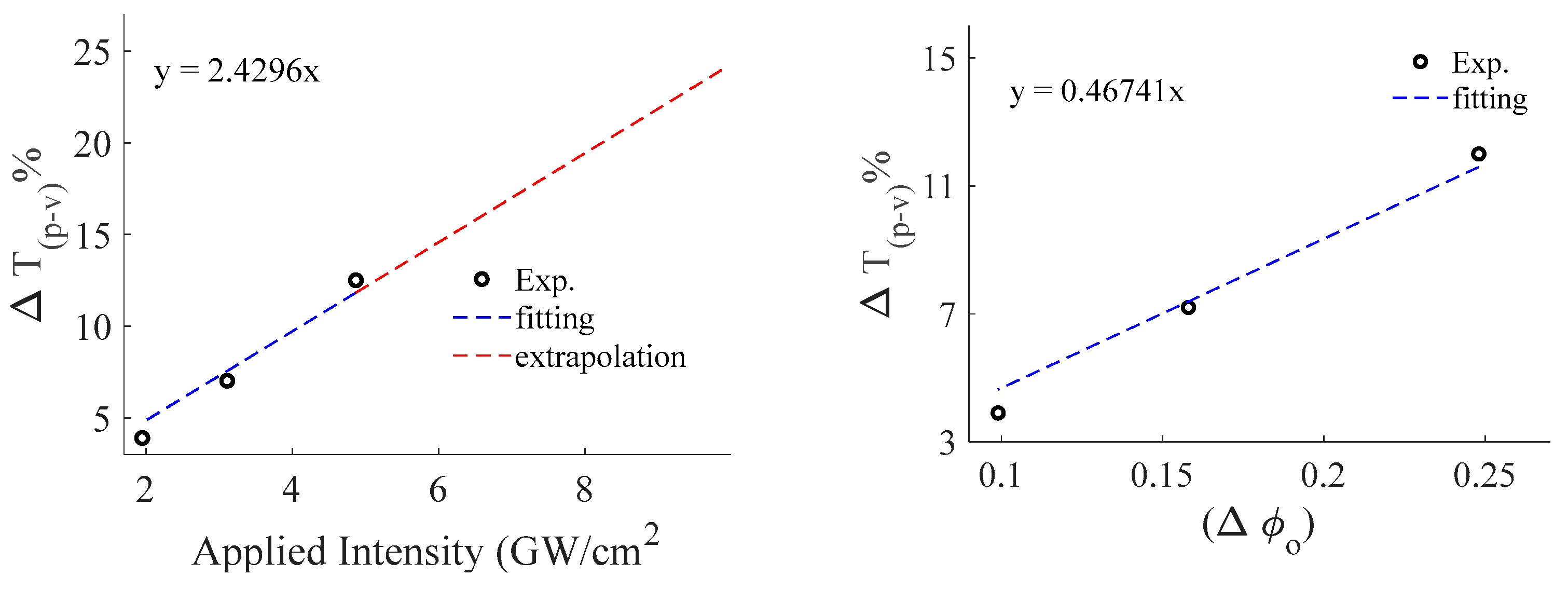
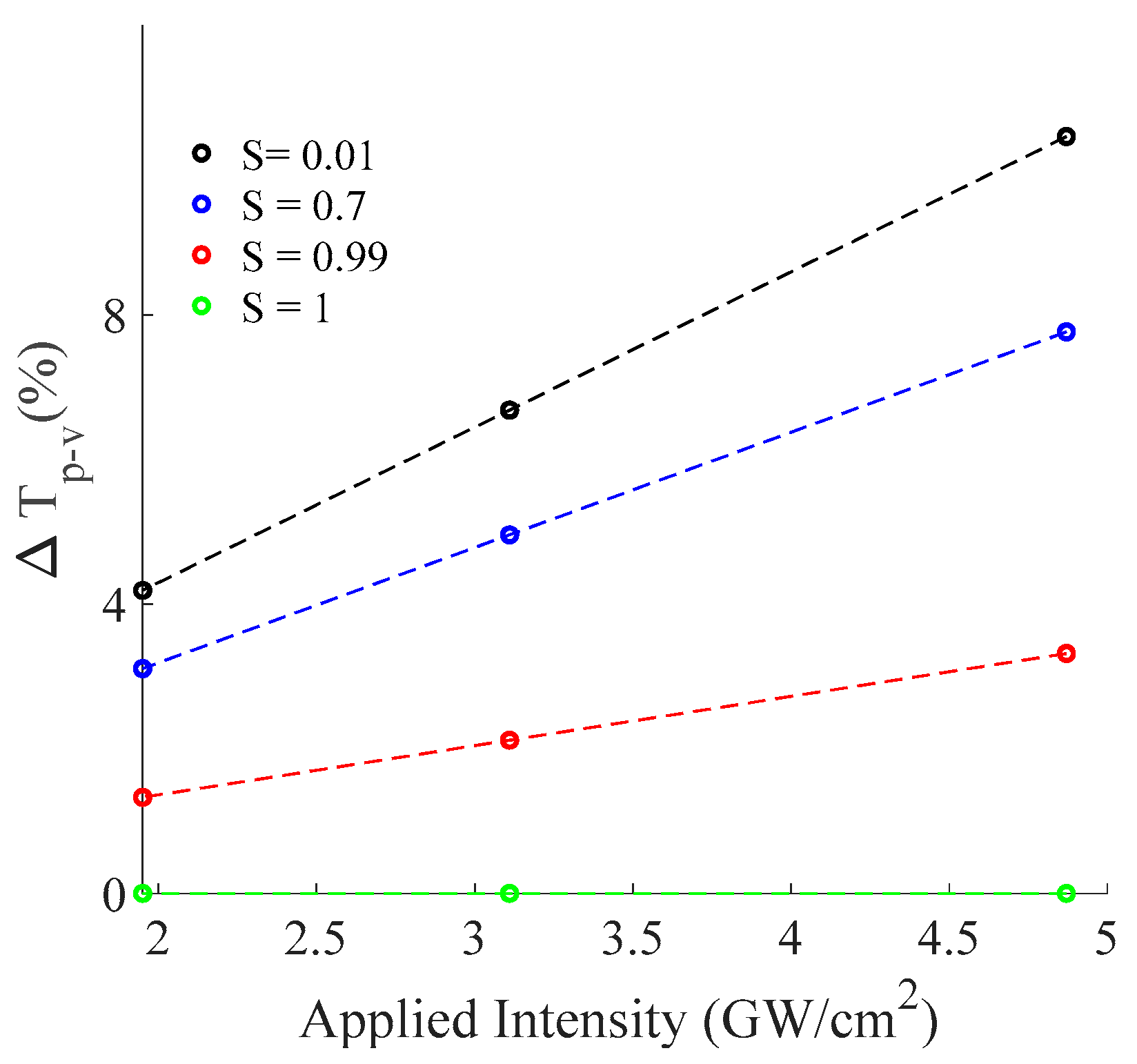
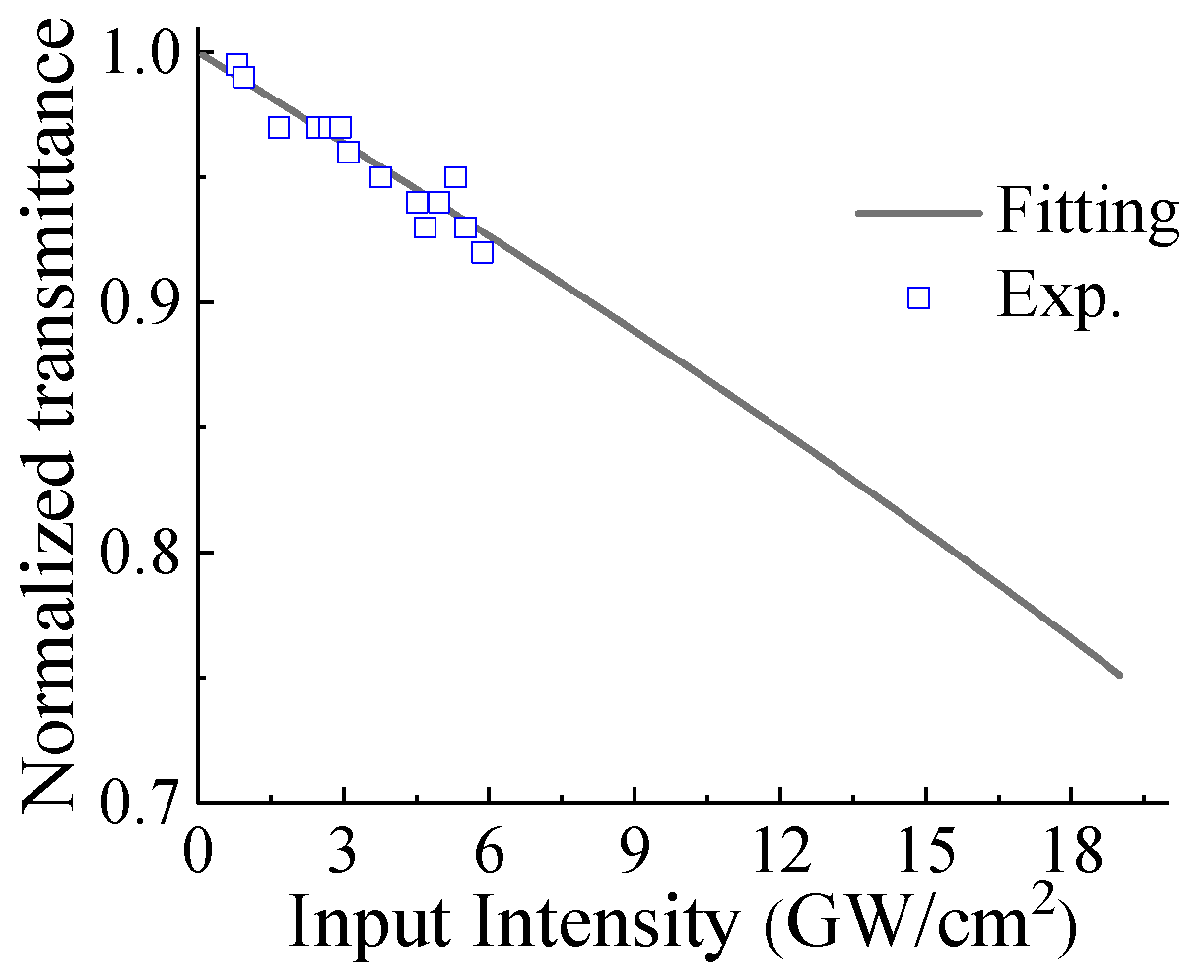
Disclaimer/Publisher’s Note: The statements, opinions and data contained in all publications are solely those of the individual author(s) and contributor(s) and not of MDPI and/or the editor(s). MDPI and/or the editor(s) disclaim responsibility for any injury to people or property resulting from any ideas, methods, instructions or products referred to in the content. |
© 2023 by the authors. Licensee MDPI, Basel, Switzerland. This article is an open access article distributed under the terms and conditions of the Creative Commons Attribution (CC BY) license (http://creativecommons.org/licenses/by/4.0/).




